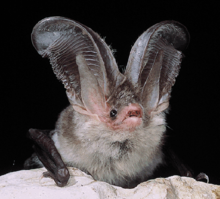| Sardinian long-eared bat | |
|---|---|

| |
| Scientific classification | |
| Domain: | Eukaryota |
| Kingdom: | Animalia |
| Phylum: | Chordata |
| Class: | Mammalia |
| Order: | Chiroptera |
| Family: | Vespertilionidae |
| Genus: | Plecotus |
| Species: | P. sardus
|
| Binomial name | |
| Plecotus sardus Mucedda, Kiefer, Pidincedda and Vieth 2002
| |
The Sardinian long-eared bat (Plecotus sardus) is a critically-endangered species of bat endemic to Sardinia, Italy.
This species was discovered in 2002 in the caves of central Sardinia, the type locality being a cave in Lanaitto's Valley in the Oliena District.[2] It appears to be closely related to Plecotus auritus and Plecotus macrobullaris.[2] It was identified as a new species by a study clearly showing divergence from other Plecotus species in its mitochondrial 16S rRNA gene.[3]
YouTube Encyclopedic
-
1/5Views:42 395928 4262 39234 24949 716
-
CHINESE EXPORT PORCELAIN OF THE 1800s
-
15 Goats You Won’t Believe Actually Exist
-
What drives ageing and can we slow down the clock? | Prof Alexey Moskalev
-
Ancient Egypt - Life and Death in the Valley of the Kings | Part 2 | Free Documentary History
-
Food History: Nachos
Transcription
Description
P. sardus is a small bat with a head-and-body length of about 45 mm (1.8 in), ears of about 38 mm (1.5 in) and a weight of up to 9 g (0.32 oz). The snout is cone-shaped with a fleshy knob on the chin. The ears are oval and joined above the forehead by a fine membrane. The tragus is tapered with a blunt tip and is half as long as the ear. The wing membranes are attached to the rear part of the base of the fifth toe. The tail is long and extends a short way beyond the interfemoral membrane. The fur is fine, long and woolly and is greyish-brown dorsally and whitish or pale brown ventrally. The wing membranes are brown. Two features which distinguish this bat from related species are the cylindrical penis in males and the short, Y-shaped penile bone.[3]
Status
The Sardinian long-eared bat was first identified in 2002 and is only known from three caves where it roosts. Two of these are in the Gennargentu National Park and one near the coast. It hunts in forests and the threats it faces include habitat loss and disturbance by tourism. With a small total population and a decreasing population trend, the International Union for Conservation of Nature lists it as being a "critically endangered species".[1] This bat is the sole surviving endemic mammal found on the Island of Sardinia, the others all having become extinct since the arrival of humans some 8500 years ago.[4]
References
- ^ a b Russo, D.; Cistrone, L. (2023). "Plecotus sardus". IUCN Red List of Threatened Species. 2023: e.T136503A211020578. doi:10.2305/IUCN.UK.2023-1.RLTS.T136503A211020578.en. Retrieved 12 January 2024.
- ^ a b Simmons, N.B. (2005). "Order Chiroptera". In Wilson, D.E.; Reeder, D.M (eds.). Mammal Species of the World: A Taxonomic and Geographic Reference (3rd ed.). Johns Hopkins University Press. p. 483. ISBN 978-0-8018-8221-0. OCLC 62265494.
- ^ a b Mucceda, M.; Kiefer, A.; Pidincedda, E.; Veith, M. (2002). "A new species of long-eared bat (Chiroptera, Vespertilionidae) from Sardinia (Italy)" (PDF). Acta Chiropterologica. 4 (2): 121–135. doi:10.3161/001.004.0202.
- ^ Amori,Giovanni; Gippoliti, Spartaco; Luiselli, Luca (2013). "A short review of the roles of climate and man in mammal extinctions during the Anthropocene". Anthropocene—Natural and Man-made Alterations of the Earth's Fragile Equilibrium. 25: 95–99. doi:10.1007/s12210-013-0240-6. S2CID 84651348.
- Spitzenberger, F.; Strelkov, P. P.; Winkler, H.; Haring, E. (2006-05-16). "A preliminary revision of the genus Plecotus (Chiroptera, Vespertilionidae) based on genetic and morphological results". Zoologica Scripta. 35 (3): 187–230. doi:10.1111/j.1463-6409.2006.00224.x. S2CID 86065200.

